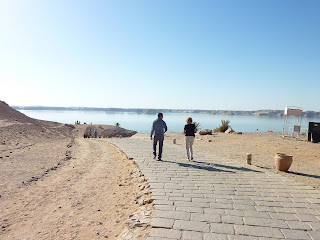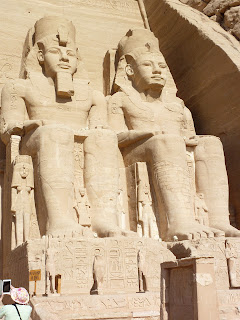Abu Simbel Temples are two massive rock temples at Abu Simbel, a village in Numibia, southern Egypt, near the border with Sudan. They are situated about 230 km (145 ml) southwest from Aswan, 300 km by the road (188 ml). The complex is part of the UNESCO World Heritage Site known as the "Nubian Monuments" which run from Abu Simbel downriver to Philae (near Aswan). The twin temples were originally carved out of the mountainside during the reign of Pharaoh Ramesses II in the 13th century BC, as a lasting monument to himself and his queen Nefertari, to commemorate his victory at the Battle of Kadesh. Their huge external rock relief figures have become iconic. The complex was relocated in its entirety in 1968, on an artificial hill made from a domed structure, high above the Aswan High Dam reservoir. The relocation of the temples was necessary to prevent their being submerged during the creation of Lake Nasser, the massive artificial water reservoir formed after the building of the Aswan High Dam on the Nile River. Construction of the temple complex started in approximately 1264 BCE and lasted for about 20 years, until 1244 BCE. Known as the "Temple of Ramesses, beloved by Amun" it was one of six rock temples erected in Nubia during the long reign of Ramesses II. Their purpose was to impress Egypt's southern neighbours, and also to reinforce the status of Egyptian religion in the region.
The complex consists of two temples. The larger one is dedicated to Ra-Harakhty, Ptah and Amun, Egypt's three state gods of the time, and features four large statues of Ramesses II in the facade. The smaller temple is dedicated to the goddess Hathor, personified by Nefertari, Ramesses's most beloved of his many wives. The temple is now open to the public. We went there by private car and driver, accompanied by our new guide for Aswan, Nile Cruise and Luxor, Mr. Rajab Alazab, very educated young Egyptologist, speaking excellent English. They came to pick from the Cruise Ship very yearly in the morning. We met the sunrise in the Nubian Desert. We needed 3 hours driving to there, 2 hours for sight-seeing and 3 more hours back. It was 1 full working day for them. We were very much satisfied from the journey through the South Sahara (Nubian) Desert and the seeing and going around the temples. In this blog- album are given the best photos from around the Temples. Inside the Temples was forbidden to take photos.






























No comments:
Post a Comment